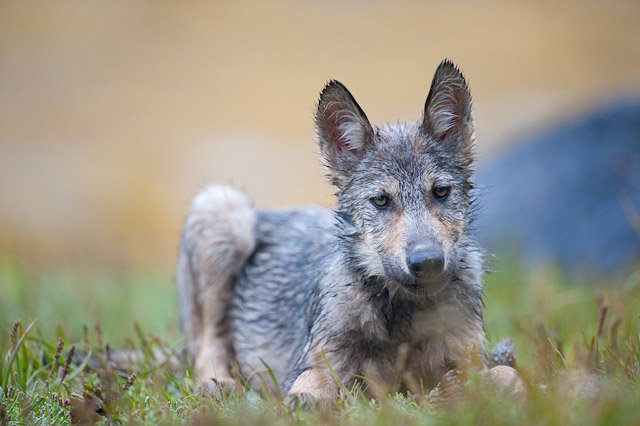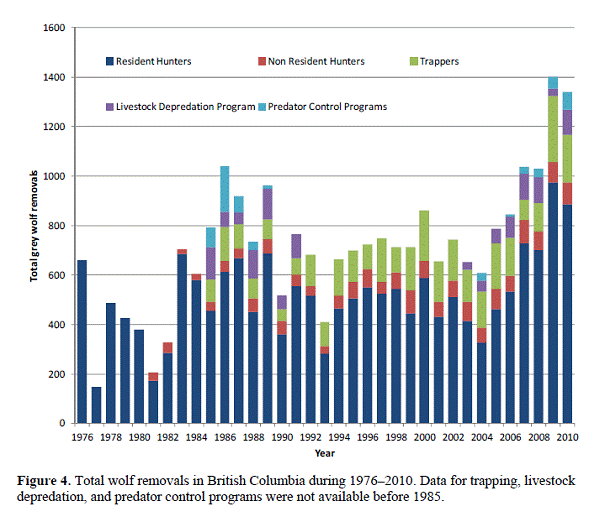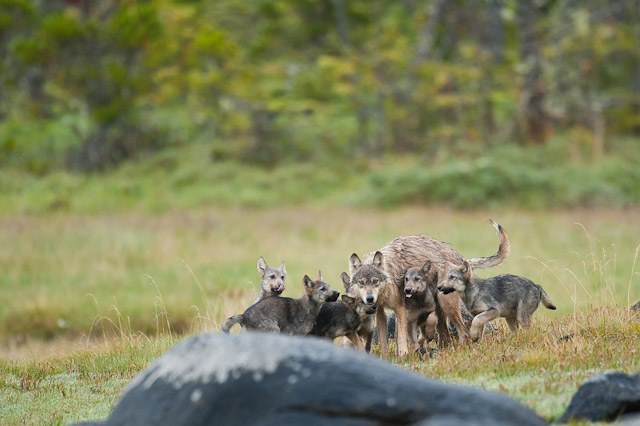|
| |
| 29. November 2012 |
| Krieg gegen Wölfe in BC. Provinzregierung legt neuen Wolf Management Plan vor |
| |
| Am 14. November 2012 hat das Ministry of Forests, Lands and Natural Resource Operations von BC einen neuen Wolf Management Plan vorgelegt, zu dem sich die Öffentlichkeit bis 5. Dezember noch äußern darf. Danach soll dieser Plan endgültig ausgearbeitet und beschlossen werden. Der Plan (DRAFT Management Plan for the Grey Wolf (Canis lupus) in British Columbia. Prepared by Ministry of Forests, Lands and Natural Resource Operations. November 2012) entpuppte sich zunächst als zusammengeschustertes Stückwerk mit vielen sogar offen eingeräumten Wissens- und Informationslücken und Fehlern. Nicht einmal der lateinische Name für den Wolf in der Überschrift stimmte, statt Canis lupus stand dort Canis lupis. Zwischenzeitlich wurden die Fehler behoben, doch das Dokument selbst stellt einen Freibrief dar für einen Vernichtungsfeldzug gegen die Wölfe in BC. Wildbiologen, unabhängige Forscher und Umweltschützer sind entsetzt über die Vorschläge dieses Plans. Ian McAllister nannte den Plan „British Columbia’s war on wolves (Pressemeldung von Pacific Wild vom 14. November 2012): This wolf plan goes on to outline a barbaric and grim future for B.C. wolves that amounts to a government sponsored kill program“. Larry Pynn nannte den Plan in der Vancouver Sun vom 16. November „einen verschleierten Angriff auf die Spezies Wolf“ (B.C. Wolf management plan criticized as veiled attack on the species). |
| |
 |
| Selbst 3 – 4 Monate alte Wolfswelpen wie dieser dürfen nach dem neuen Wolfs Management Plan ganz legal getötet werden |
| © Klaus Pommerenke |
| |
| Das Ministerium geht davon aus, dass etwa 8.500 Wölfe in BC leben, eine sehr hoch angesetzte Zahl, die von Wildbiologen angezweifelt wird. Im Wolf Management Plan heißt es gleichzeitig: „Although there is a positive bias in resident harvest statistics, the number of wolves being harvested has increased significantly in recent years.“ Wolfsabschüsse müssen in den meisten Teilen von BC nicht gemeldet werden und so beruhen die Daten des Ministeriums auf unvollständigen „good-will“-Angaben und Schätzungen. 2009 sind nach Ministeriumsangaben 1.400 Wölfe in BC getötet worden, 2010 nur unwesentlich weniger. Die untere Grenze für die Populationsgrenze der Wölfe in BC liegt bei nur 6.100, die obere bei 10.800. Für beide Zahlen ist die Anzahl der getöteten Wölfe erschreckend hoch. Die Wolfsdichte in guten Wolfsrevieren liegt bei 30 – 35 Wölfen auf 1.000 km². Im Gebiet der Nationalparks Banff und Jasper sind es nur zwei bis fünf Wölfe auf 1.000 km². Jagdsaison auf Wölfe ist je nach Gebiet vom 1. August oder 10. September bis zum 15. Juni, in manchen Gebieten dürfen sie ganzjährig ohne jede Einschränkung getötet werden – Welpen, trächtige Weibchen, ganze Rudel. Die Welpen (normalerweise zwischen vier und sieben pro Wurf) werden im April oder Mai geboren. Der ganz legale Abschuss einer Wölfin, die Welpen zu versorgen hat, zu Beginn der Jagdsaison im August oder September bedeutet regelmäßig auch den Tod der Welpen, eine bewusst beabsichtigte Nebenwirkung des gültigen Jagdgesetzes. 1950 begann die Provinz BC Wölfe zu vergiften, mit Zyanid- und Strychnin-Ködern und tötete dabei viele andere Wildtiere gleich mit. Das großflächige Vergiften der Wölfe in Wildnisgebieten endete erst 1961, das Ködern erst 1999. 2003 begann das sogenannte „predator removal program“, um Vieh vor seltenen Wolfsangriffen in manchen Gebieten zu schützen. Wölfe wurden gezielt getötet, umgesiedelt, sterilisiert. Jetzt hat die „Wolfs-Ernte“ – wolf harvest – wie es im Bericht heißt stark zugenommen, von knapp über 400 getöteten Wölfen im Jahr 1992 auf 1.400 im Jahr 2010 (vgl. Figure 4 des Wolf Management Plans). Zum zynisch-perfiden Begriff der „Wolfs-Ernte“ schreibt Ian McAllister: „The plan is full of discussion on the ‚harvesting‘ of wolves, as if they are some kind of crop like wheat or barley. It further states the lofty objective to ‚… ensure self-sustaining populations throughout the species range‘. But what does this mean for wolves in this province when the government reports that more than 34 % of a wolf population can be harvested ‚sustainably‘“. |
| |
 |
|
Schätzungen der Provinzregierung über Wolfstötungen, verharmlosend „Wolfs-Entfernungen“ genannt in BC von 1976 – 2010. Die tatsächlichen Wolfstötungen dürften weit über diesen Schätzungen liegen
|
|
© Ministry of Forests, Lands and Natural Resource Operations.
Draft Management Plan for the Grey Wolf (Canis lupus) in British Columbia, S. 18
|
| |
| Der Wolf Management Plan sieht jetzt zwei Zonen vor. Überall dort, wo Farmer Vieh halten oder gefährdete Tierarten wie die bedrohten Bergkaribus leben, dürfen Wölfe ganzjährig ohne jede Begrenzung, d. h. in unbeschränkter Zahl getötet werden. Ganze Wolfsrudel dürfen komplett vernichtet werden selbst dann, wenn die Gefahr für Viehherden minimal ist. Nach Angaben der Viehzüchtervereinigung (B.C. Cattlemen’s Association) wurden allein im Jahr 2011 60 Wölfe getötet, um Vieh zu schützen. Angeblich töten Wölfe jährlich Vieh im Wert von 15 Millionen CAD. Wie absurd überhöht und unglaubwürdig diese Angaben der Viehzüchtervereinigung sind, beschreibt Stephen Hume in der Vancouver Sun vom 9. Oktober 2012 (Livestock stats don’t justify wolf cull. Reported losses by Cattlemen’s Association differ greatly from provincial records): „For wolves to destroy $15 Million worth of livestock using yearling steers as the yardstick, they’d have to kill 19.736 animals. But Statistics Canada’s 2011 inventory for steers aged one year and over in B.C. totals 21.000 head. So, wolves would have to wipe out the entire provincial herd of yearling steers – every year. Consider it another way. Wolves primarily seek undersized, weak or immature prey. Their preferred targets aren’t mature bulls but calves. Let’s work through the loss estimate using calves as a yardstick. If the average calf at birth weighs about 25 kilograms and is valued at about $70, then wolves must kill more than 215.000 calves every year to achieve the estimated $15 million loss. But the entire inventory of beef calves for B.C. was reported at 153.000 for 2011. So wolves must kill 62.000 more calves than there actually are to achieve the loss total.“ |
| In den anderen Gebieten, in denen Farmer kein Vieh halten, regeln großzügigste Jagdzeiten und erlaubte Tötungszahlen die Dezimierung der Wölfe. Genauere Kenntnisse der Größe der Wolfspopulationen in einem Gebiet seien gar nicht notwendig, Hauptsache es werden möglichst viele abgeschossen: „As noted by Boitani (2003), ‚While accurate estimates (of wolves) are neccessary in scientific studies, the same accuracy is not always required for management and conservation planning. The order of magnitude of a population, or even its trend, is often sufficient to decide on conservation actions‘“ (Seite 19 des Berichts). Wohlgemerkt – der jetzt vorgelegte Bericht beruft sich ausdrücklich auf „the best available scientific information“. |
| Die Jagdregeln sollen so verändert werden, dass es maximale Möglichkeiten zur Tötung von Wölfen gibt. Dabei soll einer Ethik wie z. B. einer fairen Jagd und einer menschlichen Behandlung Anerkennung gezollt werden: „Ethics such as fair chase and humane treatment are recognized“ (S. 20 des Berichts). Jegliche Form der Jagd soll erlaubt sein, auch der Abschuss ganzer Rudel vom Helikopter aus. „Aerial shooting is the most effective and human“, heißt es bei dem genannten „Management Tools“ zur Wolfstötung. |
| Weiter heißt es in dem Bericht: „… regulations are frequently designed to encourage harvest. Seasons are long and there is no species license required for residents to hunt wolves. There is no age/sex restriction, as this type of restriction is infeasible for wolves: Age or sex cannot be identified reliable in the field and the pack structure of populations renders management by sex and age ineffective“ (Seite 20). Es scheint den Wolfsjägern intellektuell nicht zugemutet werden zu können, selbst zwischen wenige Monate alten Wolfswelpen und erwachsenen Wölfen zu unterscheiden, sie dürfen auf alles schießen, was nach Wolf aussieht. „This means that any B.C. resident can legally kill pups, pregnant females without mandatory reporting. Already, the B.C. government has opened up huge parks of the province to open seasons, year-round hunting without any limit to the amount of wolves killed“, erklärte Ian McAllister. |
| |
 |
| Trächtige Weibchen, Welpen, Wölfe jeden Alters, ganze Rudel dürfen nach dem Wolf Management Plan von Helikoptern aus getötet werden |
| © Klaus Pommerenke |
| |
| Da der Conservation Officer Service personell völlig ausgeblutet ist und bei Mensch-Haustier-Konflikten seiner Kontrollfunktion schon längst nicht mehr nachkommen kann, soll jetzt die Verantwortung für das Konfliktmanagement Landbesitzern, Viehzüchtern, der Trophäenjägervereinigung (BC Guide Outfitters Association) und der Agrarindustrie übertragen werden. Kurz gesagt, man will den Bock zum Gärtner machen, wohlwissend, in welchem Sinne dann auch noch so kleine Konflikte gelöst werden. |
| Anstatt die Lebensräume der bedrohten Bergkaribus endlich komplett zu schützen, sollen in deren Lebensräume bzw. entlang der Wanderrouten der Bergkaribus systematisch Wölfe getötet werden. Nicht die Wölfe, sondern der Verlust des Lebensraumes droht seit vielen Jahrzehnten die Bergkaribus auszurotten. „The ultimate reason that caribou have declined is likely habitat fragmentation and loss, but proximate factors such as predation continue to limit population recovery even where suitable habitat is extensive and secure, relative to the size of the caribou herd“, heißt es im Bericht (Seite 22). Deshalb wird vorgeschlagen: „Removal of all resident packs and/or individuals is a legitimate goal where even rare predation events would further jeopardize the viability of a caribou herd … many biologists doubt that recovery objectives can be met without resorting to shooting wolves from helicopters, which they consider to be most effective and human approach.“ Die Schlussfolgerung lautet: „… an aerial wolf reduction program for wolves that threaten caribou herds of fewer than 50 animals should be implemented“ (Bericht S. 24). In seinem Artikel in der Globe and Mail vom 18. November (Caribou, wolves or development?) weist Mark Hume auf ein viel grundlegenderes Problem hin, welches in Zusammenhang mit dem drohenden Aussterben der Bergkaribus im Nordosten von BC diskutiert werden muss: „Caribou populations are declining so quickly along the proposed Enbridge Northern Gateway pipeline route that British Columbians are now faced with a stark choice: kill wolves to save the caribou or halt development … Widespread development in the booming oil-and-gas area has opened up the forest habitat, boosting moose and deer populations by providing rich browsing range. In the past, wolf numbers rose and fell in synchronicity with the caribou population. But with more moose and deer around, wolf numbers have stayed high, disrupting the natural predator-prey symbiosis. Put simply, the caribou are literally taking it in the neck, with wolves causing 40 per cent of all mortalities. And now Enbridge is proposing to put the Gateway pipeline right through the middle of that caribou range, which would open up the woodlands even more, exacerbating an already severe wolf-predation problem. The numbers show how desperate the situation is. In recent years, the Moberly herd has gone from 191 caribou to 35. The Bearhole-Redwillow herd has dwindled to 21 animals from 80. And when biologists went looking for the Burnt-Pine herd of 17 caribou this year, they could only find one animal left alive – standing alone in a tract of forest where there hasn’t been a new calf born in four years. Any doubt that the pipeline route passes through caribou habitat was removed by a recent study in which Ms. Jones and Dale Seip tracked animals using radio collars. They found that over the course of a year several herds (and particularly the Bearhole-Redwillow population) criss-cross the pipeline right of way many times, moving between feeding and calving grounds.“ |
| |
 |
| Wolfswelpe, zukünftig in weiten Landesteilen von BC ohne jeden Schutz, sie sind in unbegrenzter Zahl zum Abschuss freigegeben |
| © Klaus Pommerenke |
| |
| Nachfolgend ist der Aufruf der Valhalla Wilderness Society und von Pacific Wild abgedruckt, um gegen den jetzt vorgelegten Wolf Management Plan – einem von der Provinz geförderten Wolfs-Tötungsprogramm – zu protestieren. Helfen Sie mit, dass dieser Wolf Management Plan nie von der Provinzregierung umgesetzt werden wird! Bitte klicken Sie auf den unten angegebenen Link zur Provinzregierung von British Columbia, Ministry of Forests, Lands and Natural Resource Operations und schreiben Sie Ihren Protestbrief in das Fenster „submit comments“, das sich öffnet. Sie können gerne die im Folgenden gemachten Vorschläge (recommendations) übernehmen und um Ihre eigenen Vorschläge und Kommentare ergänzen. |
| |
| ACTION ALERT! |
| PLEASE HELP PROTECT BRITISH COLUMBIA’S WOLVES |
- Increased killing of wolves to protect cattle
- Machine-gunning wolf packs from helicopters to protect caribou
- No place in BC where wolves will be protected to live a natural pack life
- No designated areas for nonconsumptive uses such as wolf viewing, photography and scientific research
- Tying the Conservation Officers up in partnership with cattlemen, hunters associations
|
| ALL TO BE ENSHRINED IN A WOLF MANAGEMENT PLAN UNLESS ENOUGH PEOPLE OBJECT |
Public input deadline is December 5. It’s easy to submit your comments at:
www.env.gov.bc.ca/fw/public-consultation/grey-wolf/ |
| The BC government has pulled a fast one. The draft Wolf Management Plan was released on November 14, and the deadline for public input is December 5. There is now a little more than 2 weeks to respond. You can download it from the government website link above. But for those who don’t have the time to read and digest 49 pages of material, we offer this rather long analysis. |
| The draft Management Plan honestly admits that wolves play a key role in healthy ecosystems, that 11 years of killing wolves in caribou habitat has not resulted in more caribou, and that current figures for wolf populations are unreliable. It speaks of maintaining balance between conservation of wolves and killing them, and claims the goal of ensuring „self-sustaining populations“ of wolves. Yet the Plan clearly intends: |
- Increased killing of wolves to please the rancher lobby
- Intensified killing of whole wolf packs under the pretext of saving mountain caribou
- Embedding hunter and rancher lobby groups in partnership with BC’s Conservation
|
| Officer (CO) Service. The government has made severe budget and staff cuts to the CO service, now this is the next step: putting vested interests in control of managing our wildlife. |
| And the deck has been loaded towards helicopter killing with the claim that this is the most efficient and „humane“ way to go about protecting caribou. Let’s be really honest: allowing ranchers to have open season on wolves and shooting whole packs from helicopters with automatic weapons takes us back to the ignorant, cruel days when wolves were called „vermin“ and viewed as rats to be killed anywhere, any time, by anybody. And despite the talk of „balance“, the draft plan offers no management actions to recognize other values of wolves such as their intrinsic worth as living things, their role in maintaining healthy ecosystems, and their tourism/wildlife viewing values. |
| This draft Plan would enshrine the government’s War on Wolves in formal policy: a policy based on scapegoating wolves for problems caused by people; a policy that would continue our cultural misbeliefs that constant shooting and trapping of wolves is the only way to treat them. |
| Already, more wolves are being killed than at any time since kills began to be recorded in 1976. |
| According to the draft Plan, the number of recorded kills hit an all-time high for that period during 2011, with 1,400 wolves killed. But many, if not most wolf kills are not reported. |
| |
| RECOMMENDATIONS |
- Extend the deadline for public input to January 30, 2013
- Set aside large areas of the province where wolves are protected from any killing, so that wolves can develop natural packs and behaviour, which will provide benchmarks for scientific research and as areas where people can watch wolves
- NO helicopter killing of wolves
- NO leghold traps or snares
- By the draft Plan’s own admissions, 11 years of killing wolves to save caribou have not increased caribou. These programs have failed and should be stopped
- The government has acknowledged that the chief reason for mountain caribou decline is loss of habitat. A secondary reason is snowmobiling and heli-skiing in winter habitat. To save caribou the government should 1) stop logging old-growth forest in mountain caribou range, 2) ban snowmobiles from winter range (current bans are inadquate and not enforced), and 3) roads built in caribou range need to be obliterated to prevent easy access by predators
- Return to former species licence, quotas, bag limits, restricted seasons, and mandatory reporting of kills for hunting wolves
- Continue government programs for compensating ranchers for losses to wild predators
- Fund an adequate Conservation Officer Service. The Conservation Officer Service should not partner with vested interests such as ranchers; this is the foxes running the chicken coop
- Practice prevention by providing education and incentives to improve protection with fences, guard dogs, shepherds, etc.
|
As of the date of this Action Alert you have 16 days to make a comment at:
www.env.gov.bc.ca/fw/public-consultation/grey-wolf/ |
| |
 zurück zurück |
|
|

